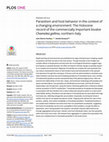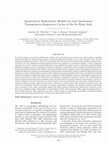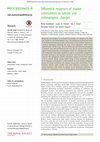Papers by Daniele Scarponi
2005 Salt Lake City Annual Meeting, Oct 16, 2005
Biological veracity of the sharp diversity increase observed in many analyses of the post-Paleozo... more Biological veracity of the sharp diversity increase observed in many analyses of the post-Paleozoic marine fossil record has been debated vigorously in recent years. This pertains both to global synoptic curves as well as sample-level species richness patterns. Here, we add more fuel to the debate by comparing Jurassic, Late Cretaceous, and Neogene shelly fauna sampled at comparable spatial scales and restricted to comparable open marine siliciclastic facies.
R script of the analyses in this manuscript
Geological Society of America Abstracts with Programs, 2017

Theacceleratingincreaseinglobaltemperatureandconcomitantsealevelrisemayresultinanincreasedprevale... more Theacceleratingincreaseinglobaltemperatureandconcomitantsealevelrisemayresultinanincreasedprevalence (i.e.infestationfrequency)ofmanypathogensandparasites.UsingtheHolocenebrackishdepositsofthePoPlain, we evaluate this issue from a historical perspective by documenting temporal changes in trematode infestation of mollusk hosts during high-frequency (102-103 yrs) sea-level \ufb02uctuations that took place over the most recent millennia. During that time interval, the dominant bivalve species, Abra segmentum, was frequently infested by trematodes. Median body size was signi\ufb01cantly larger in infested individuals (p = 2.21*10-34), likely re\ufb02ecting accumulation of parasites with ontogenetic age. Prevalence estimates were signi\ufb01cantly elevated (p < 0.01) in samples of A. segmentum associated with \ufb02ooding surfaces and signi\ufb01cantly depressed (p < 0.01) in intervening samples.Incontrast,temporaltrendsinhostbodysize,hostavailability,salinity,diversity,turnover,andcommunity structure did not correlate signi\ufb01cantly with parasite prevalence. The results reported here reinforce the recently proposedhypothesisthatincreasingtrematodeprevalenceislinkedto\ufb02oodingevents,apatternnowdocumentedin shallowmarineandestuarinesettingsontwocontinents,inbothmodernandfossiltaxa.Consequently,theongoing anthropogenic warming and sea-level rise is expected to trigger a signi\ufb01cant upsurge in trematode prevalence, resulting in suppressed fecundity of common benthic organisms and negative impacts on marine ecosystems and ecosystem services

Stratigraphic patterns of last occurrences (LOs) of fossil taxa potentially fingerprint mass exti... more Stratigraphic patterns of last occurrences (LOs) of fossil taxa potentially fingerprint mass extinctions and delineate rates and geometries of those events. Although empirical studies of mass extinctions recognize that random sampling causes LOs to occur earlier than the time of extinction (Signor–Lipps effect), sequence stratigraphic controls on the position of LOs are rarely considered. By tracing stratigraphic ranges of extant mollusc species preserved in the Holocene succession of the Po coastal plain (Italy), we demonstrated that, if mass extinction took place today, complex but entirely false extinction patterns would be recorded regionally due to shifts in local community composition and non-random variation in the abundance of skeletal remains, both controlled by relative sea-level changes. Consequently, rather than following an apparent gradual pattern expected from the Signor–Lipps effect, LOs concentrated within intervals of stratigraphic condensation and strong facies shifts mimicking sudden extinction pulses. Methods assuming uniform recovery potential of fossils falsely supported stepwise extinction patterns among studied species and systematically underestimated their stratigraphic ranges. Such effects of stratigraphic architecture, co-produced by ecological, sedimentary and taphonomic processes, can easily confound interpretations of the timing, duration and selectivity of mass extinction events. Our results highlight the necessity of accounting for palaeoenvironmental and sequence stratigraphic context when inferring extinction dynamics from the fossil record.

PLOS ONE, 2021
Rapid warming and sea-level rise are predicted to be major driving forces in shaping coastal ecos... more Rapid warming and sea-level rise are predicted to be major driving forces in shaping coastal ecosystems and their services in the next century. Though forecasts of the multiple and complex effects of temperature and sea-level rise on ecological interactions suggest negative impacts on parasite diversity, the effect of long term climate change on parasite dynamics is complex and unresolved. Digenean trematodes are complex life cycle parasites that can induce characteristic traces on their bivalve hosts and hold potential to infer parasite host-dynamics through time and space. Previous work has demonstrated a consistent association between sea level rise and increasing prevalence of trematode traces, but a number of fundamental questions remain unanswered about this paleoecological proxy. Here we examine the relationships of host size, shape, and functional morphology with parasite prevalence and abundance, how parasites are distributed across hosts, and how all of these relationships...

Radiocarbon, 2021
ABSTRACTThe direct carbonate procedure for accelerator mass spectrometry radiocarbon (AMS 14C) da... more ABSTRACTThe direct carbonate procedure for accelerator mass spectrometry radiocarbon (AMS 14C) dating of submilligram samples of biogenic carbonate without graphitization is becoming widely used in a variety of studies. We compare the results of 153 paired direct carbonate and standard graphite 14C determinations on single specimens of an assortment of biogenic carbonates. A reduced major axis regression shows a strong relationship between direct carbonate and graphite percent Modern Carbon (pMC) values (m = 0.996; 95% CI [0.991–1.001]). An analysis of differences and a 95% confidence interval on pMC values reveals that there is no significant difference between direct carbonate and graphite pMC values for 76% of analyzed specimens, although variation in direct carbonate pMC is underestimated. The difference between the two methods is typically within 2 pMC, with 61% of direct carbonate pMC measurements being higher than their paired graphite counterpart. Of the 36 specimens that di...
Geological Society of America Abstracts with Programs, 2018

Geological Society of America Abstracts with Programs, 2016
Previous work in Late Pleistocene\u2013Holocene sequences from the Po plain revealed significant ... more Previous work in Late Pleistocene\u2013Holocene sequences from the Po plain revealed significant long-term fluctuations in trematode prevalence in marine environments: higher prevalence in retrogradational environments (TST) and negligible prevalence in progradational environments (HST). Here we expand upon this work by investigating traces of trematode parasitism among bivalves within parasequence sets from the Holocene brackish deposits of the Po Plain. The investigated portion of core 204-S7 is 24 m long and, from bottom to top, includes 5 m of amalgamated fluvial channel sands (latest Pleistocene) followed upwards by alternating packages of swamp and poorly drained floodplain deposits. The middle part of the core includes brackish deposits (inner to outer lagoon) accumulated through the Holocene. Using dense sampling (32 bulk samples and >1,550 specimens) of wetland and lagoonal strata from core 204-S7, we documented trematode occurrences in Abra segmentum, Loripes orbiculatus, and Cerastoderma glaucum. A randomization (10,000 iterations) at the level of individual specimens was conducted to investigate the statistical significance of the observed variability in trematode frequency. Frequencies of trematode infestation of A. segmentum were significantly elevated (p < 0.01) in samples associated with flooding surfaces and significantly depressed (p < 0.01) in samples collected from in-between flooding surfaces. Frequencies of termatode occurrences were similarly elevated around flooding surfaces in the case of L. orbiculatus. However, frequencies of trematode infestations in C. glaucum did not vary signinficantly across samples likely refelcting their low abundance. These results, documented at a much finer scale of observation within the sequence stratigraphic framework (dissecting parasequences) than in our previous studies (comparing data pooled by systems tracts), further support the hypothesis that increasing trematode prevalence is linked to transgressive cycles, a pattern now documented in shallow marine and estuarine settings, on two continents, and in both modern and fossil taxa
Acta Palaeontologica Polonica, 2015
BioOne Complete (complete.BioOne.org) is a full-text database of 200 subscribed and open-access t... more BioOne Complete (complete.BioOne.org) is a full-text database of 200 subscribed and open-access titles in the biological, ecological, and environmental sciences published by nonprofit societies, associations, museums, institutions, and presses.

Paleobiology, 2012
The role of antagonistic organismal interactions in the production of long-term macroevolutionary... more The role of antagonistic organismal interactions in the production of long-term macroevolutionary trends has been debated for decades. Some evidence seems to suggest that temporal trends in predation frequency share a common causative mechanism with genus-level diversity, whereas studies on the role of parasites in ''shaping'' the evolutionary process are rare indeed. Digenean trematodes (Phylum Platyhelminthes) infest molluscs in at least one stage of their complex life cycle. Trematodes leave characteristic oval-shaped pits with raised rims on the interior of their bivalve hosts, and these pits are preserved in the fossil record. Here we survey 11,785 valves from the Pleistocene-Holocene deposits of the Po Plain and from nearby modern coastal environments on the northeast Adriatic coast of Italy. Of these, 205 valves exhibited trematodeinduced pits. Trematodes were selective parasites in terms of host taxonomy and host body size. Infestation was restricted to lower shoreface/transition-to-platform paleoenvironments. During the Holocene, individuals from the transgressive systems tract were significantly more likely to be infested than those from highstand systems tracts. Temporal trends in infestation frequency cannot be explained as an ecological/evolutionary phenomenon (e.g., the hypothesis of escalation); instead the trend seems controlled by environmental variation induced by glacio-eustatic sea-level changes and inadequate sampling. Because this interaction appears to be ephemeral, both temporally and spatially, it is not likely that any selective pressure would be continuous over geologic time in this region. Furthermore, these results support the hypothesis that antagonistic interactions are lower in the northern Adriatic Sea in comparison to other midlatitude shallow marine settings.
Annali di storia delle università italiane, 2000
GeoActa, 2010
Part of Lodovico Foresti's (1829-1913) palaeo-malacological legacy is preserved in the G. Ca... more Part of Lodovico Foresti's (1829-1913) palaeo-malacological legacy is preserved in the G. Capellini Museum of Geology (MGGC) of Bologna University. The Foresti collection at MGGC consists of nearly 1500 Neogene and early Pleistocene molluscs representing 111 taxa, mainly from Emilia-Romagna foothills (Northern Italy). During our examination we were able to trace various type series materials on which any information was assumed to be lost. Herein we document type series material of 11 species-group taxa and designate 9 ...
The Bulletin of Zoological Nomenclature, 2011
Pleurotoma scabriuscula Brugnone, 1862 (currently Mangelia scabriuscula; Mollusca, Gastropoda, Co... more Pleurotoma scabriuscula Brugnone, 1862 (currently Mangelia scabriuscula; Mollusca, Gastropoda, Conoidea): proposed conservation ... Daniele Scarponi Dipartimento di Scienze della Terra e Geologico-Ambientali – Via Zamboni, 67 40126 Bologna – Italy (e-mail: ...

Paleobiology, 2015
Parasitic trematode worms leave characteristic pits in their bivalve mollusk hosts and represent ... more Parasitic trematode worms leave characteristic pits in their bivalve mollusk hosts and represent an ideal system for analyzing parasite-host interactions through space and time with statistically meaningful sample sizes. Previous work in Late Pleistocene-Holocene sequences from the Po plain revealed significant long-term fluctuations in trematode prevalence values: higher prevalence in retrogradational environments (TST) and negligible prevalence in progradational environments (HST). Here we expand upon this work by investigating traces of parasitism, kleptoparasitism, and predation on mollusk death assemblages from two domains along the northern Adriatic coastline. The domain north of the Po delta (TST-like) and the southern domain (including the Po delta; HST-like) comprise environments comparable to those recovered in late Holocene (<6 Kyr) subsurface progradational deposits. We collected 17,299 specimens representing 111 species from 11 locations on the northern Adriatic coast of Italy. Our results reveal high predation pressure, a high diversity of host taxa, and widespread presence of trematode infestation in starved, oligotrophic, environmentally more stable (i.e., TST-like) settings north of the Po delta. Immediately south of the Po delta, in settings with strong and variable sedimentary input, almost no infestation is recorded. The reappearance of infestation is evident in the southern portion of the study area (i.e., Cattolica-Montemarciano), relatively far from the highly stressed environments south of the Po River. There is no significant difference in trematode prevalence values between fossil and modern samples. The distribution of spionid traces (an indicator of stressed environments) was nearly the opposite of that displayed by trematodes. Drilling frequency is highest in TST-like environments and is not correlated with diversity indices. These results suggest that temporal trends of trematode prevalence (and possibly also other biotic interactions) in sedimentary successions are controlled by environmental changes driven by glacio-eustatic dynamics, and reaffirm the importance of interpreting temporal trends in the context of spatial variation.

The Journal of Geology, 2014
In marine settings, quantitative bathymetric models can be developed using various water depth pr... more In marine settings, quantitative bathymetric models can be developed using various water depth proxies, including epibiont distribution, sedimentologic features, and the distribution of benthic taxa in time and space. Here, the late Quaternary bathymetric history of the Po coastal plain (Italy) has been reconstructed using mollusk samples from a network of 16 cores. Multiple analytical approaches have been applied in a comparative fashion. A direct ordination approach was used to estimate sample bathymetry using weighted averaging of genera with known preferred depth. Weighted averaging carries an advantage of analytical simplicity and produces direct ordination models expressed in environmentally meaningful units. Indirect ordination methods, based on depth estimates developed using posterioricalibrated ordination strategies (correspondence and detrended correspondence analysis calibrated against present-day bathymetric data), yielded results consistent with weighted averaging. Regardless of the choice of analytical methods, mollusk assemblages yielded bathymetric proxies congruent with independent sequence stratigraphic interpretations derived previously for both Late Pleistocene and Holocene transgressive-regressive cycles. The mollusk-derived proxies quantify spatial bathymetric gradients across the basin and local trends in absolute water depth in response to relative changes in sea level. However, for cores located in the most proximal part of the basin, mollusk-based ordinations failed to provide viable estimates due to inclusion of mixed marine and nonmarine mollusk faunas and scarcity of fossiliferous horizons necessary for adequate quantitative sampling. The multiple analytical approaches cross evaluated in this study consistently suggest that high-resolution quantitative bathymetric estimates can be derived for mollusk samples independent of stratigraphy for fully marine settings. When applied simultaneously to both samples and taxa, these approaches provide a viable strategy for quantifying stratigraphic and paleontological patterns and enhancing interpretations of basin-scale depositional systems.

Proceedings. Biological sciences / The Royal Society, Jan 22, 2015
Responses of ecosystems to environmental changes vary greatly across habitats, organisms and obse... more Responses of ecosystems to environmental changes vary greatly across habitats, organisms and observational scales. The Quaternary fossil record of the Po Basin demonstrates that marine communities of the northern Adriatic re-emerged unchanged following the most recent glaciation, which lasted approximately 100,000 years. The Late Pleistocene and Holocene interglacial ecosystems were both dominated by the same species, species turnover rates approximated predictions of resampling models of a homogeneous system, and comparable bathymetric gradients in species composition, sample-level diversity, dominance and specimen abundance were observed in both time intervals. The interglacial Adriatic ecosystems appear to have been impervious to natural climate change either owing to their persistence during those long-term perturbations or their resilient recovery during interglacial phases of climate oscillations. By contrast, present-day communities of the northern Adriatic differ notably fro...











Uploads
Papers by Daniele Scarponi